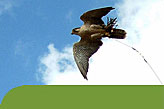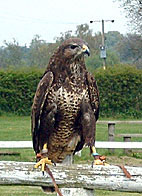

| |
Home |
| |
|
| |
About the Centre |
| |
|
| |
Our Birds |
| Falcons | |
| Hawks | |
| Buzzards | |
• |
Common Buzzard |
| Eagles | |
| Kites | |
| Vultures | |
| Owls | |
| |
|
| |
Our People |
| |
|
| |
Falconry Courses |
| |
|
| |
Links |
| |
|
| |
Injured Birds |
The Buzzard is a bird equipped with long broad wings making it superbly adapted for soaring for long distances on thermals. However, this is not their favoured method of hunting; the Buzzard in common with many other birds of prey preferring to ‘still hunt’ by sitting on a perch looking for food. Food for a Buzzard consists of predominantly of small mammals such as rabbits, although they are partial to invertebrates, often spending hours searching for earthworms, grubs and beetles. The Buzzard is also a marvellous opportunist taking the easy route to a meal whenever given the chance, this accounts for large numbers of Buzzards seen sitting atop telegraph poles by the roadside in some parts of the country searching for road kill. Sadly in Britain the Buzzard has been greatly persecuted throughout
the centuries as a pest. However, despite a variety of setbacks
the population has recovered from the brink of extinction and this
success has much to do with its resilience and opportunistic nature. |
|
| Buzzard Facts |
| Name:
Common Buzzard - Buteo buteo |

